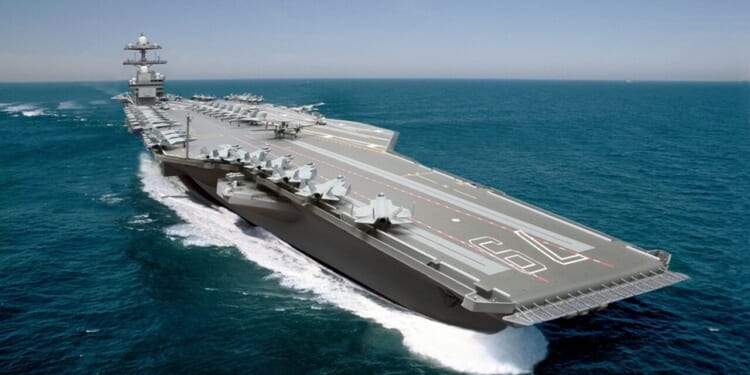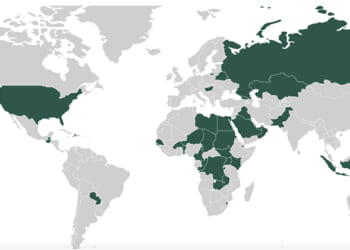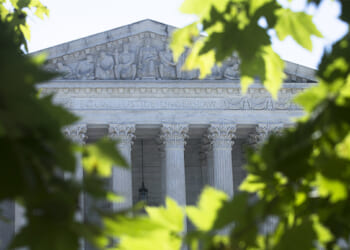Despite the attempts to streamline the carrier’s delivery process, delays remain due to issues with two critical systems: its arresting gear, crucial for aircraft landing, and its weapons elevators.
In August, the United States Navy acknowledged that the second Gerald R. Ford-class nuclear-powered aircraft carrier, the future USS John F. Kennedy (CVN-79), would not join the fleet until at least March 2027, nearly two years behind schedule. That could cause additional headaches for the sea service, as its carriers will be spread even further with USS Nimitz (CVN-68), the oldest nuclear-powered flattop, set to head into retirement next year.
For at least a year, and perhaps even longer, the US Navy will have just 10 supercarriers in its fleet on paper; however, given the delays in regular and more complex maintenance, there will likely never be more than five or six in operation at a time.
A New “Big John” Is Coming
Last week, Huntington Ingalls Industries announced that its Newport News Shipbuilding division reached a significant milestone in the construction of the Pre-Commissioning Unit (PCU) warship USS John F. Kennedy, as the carrier completed its first nuclear propulsion tests.
“Using tugboats, the ship was moved from an NNS pier into the James River, turned and moved back to the pier. The evolution will allow testing to continue as shipbuilders prepare CVN 79 for sea trials,” HII explained in a video released on YouTube showing the progress that has already been made.
Earlier this year, the US Navy also confirmed that the carrier was around 90 percent complete. The delay in it entering service is due to an altered Post-Shakedown Availability (PSA) strategy, which sought to integrate necessary modifications and efficiency improvements learned from its predecessor, the USS Gerald R. Ford (CVN-78), including adaptations for the F-35C Lightning II and the upgraded Enterprise Air Surveillance Radar.
The new PSA approach, which has received the endorsement of congressional lawmakers, was intended to replace the previously considered dual-phase delivery with a more capable single-phase delivery, ensuring the carrier’s readiness for deployment to the Indo-Pacific, where there has been an increasingly severe shortage of US warships.
Technical Delays Are Slowing the Kennedy’s Completion Date
Despite the attempts to streamline the delivery process, delays remain due to issues with two critical systems: the Advanced Arresting Gear (AAG) and the Advanced Weapons Elevators (AWE), each of which was also a serious problem with CVN-78 and remained unresolved until after the carrier had been commissioned.
As Army Recognition explained, the AAG was developed to replace the “legacy hydraulic arresting systems with an electromagnetic turbo-electric engine designed to recover a wider range of aircraft weights.” That includes lighter unmanned aerial systems (UAS). It also aims to reduce the stress loads on the aircraft’s airframes during launch.
The elevators, which also employ “electromagnetic linear motors to vertically transfer ordnance from magazines to the flight deck,” have suffered delays that are the result of adjustments that needed to be made following installation. As of this month, the systems haven’t received full certification.
“These two subsystems, combined with persistent shipyard workforce shortages and supply chain disruptions, were cited as the direct causes of the new 2027 delivery estimate,” the Army Recognition report added.
Resolving those and other problems remains a top priority. Still, due to the shortage of carriers, the Pentagon had even considered accepting CVN-79 with some “non-essential work unfinished,” notably its final painting—but it is unclear what would be gained from such a move.
The Navy Has More Delays Beyond the Carrier
In addition to the delays in the construction of the future USS John F. Kennedy, the US Navy has faced issues with its future homeport, which is currently slated to be Naval Base Kitsap-Bremerton, Washington. Because the Gerald R. Ford-class carriers employ more automation and are outfitted with advanced systems that require additional power, work has been underway to replace the existing electrical substation at the base.
The upgrades are scheduled to begin this fiscal year (FY26), which commenced on October 1, and are expected to be completed no earlier than fiscal year 2029 (FY29).
CVN-79 will be the second carrier to be named for the late president, who was assassinated in Dallas, Texas, in November 1963. The previous warship, a variant of the USS Kitty Hawk, was sold to a scrapper and will imminently be broken up in Texas.
About the Author: Peter Suciu
Peter Suciu has contributed over 3,200 published pieces to more than four dozen magazines and websites over a 30-year career in journalism. He regularly writes about military hardware, firearms history, cybersecurity, politics, and international affairs. Peter is also a contributing writer for Forbes and Clearance Jobs. He is based in Michigan. You can follow him on Twitter: @PeterSuciu. You can email the author: [email protected].
Image: Wikimedia Commons.

















